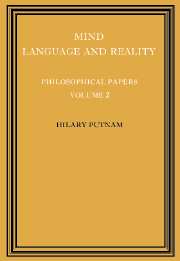Book contents
- Frontmatter
- Contents
- Dedication
- Introduction
- 1 Language and philosophy
- 2 The analytic and the synthetic
- 3 Do true assertions correspond to reality?
- 4 Some issues in the theory of grammar
- 5 The ‘innateness hypothesis’ and explanatory models in linguistics
- 6 How not to talk about meaning
- 7 Review ofThe concept of a person
- 8 Is semantics possible?
- 9 The refutation of conventionalism
- 10 Reply to Gerald Massey
- 11 Explanation and reference
- 12 The meaning of ‘meaning’
- 13 Language and reality
- 14 Philosophy and our mental life
- 15 Dreaming and ‘depth grammar’
- 16 Brains and behavior
- 17 Other minds
- 18 Minds and machines
- 19 Robots: machines or artificially created life?
- 20 The mental life of some machines
- 21 The nature of mental states
- 22 Logical positivism and the philosophy of mind
- Bibliography
- Index
19 - Robots: machines or artificially created life?
Published online by Cambridge University Press: 12 January 2010
- Frontmatter
- Contents
- Dedication
- Introduction
- 1 Language and philosophy
- 2 The analytic and the synthetic
- 3 Do true assertions correspond to reality?
- 4 Some issues in the theory of grammar
- 5 The ‘innateness hypothesis’ and explanatory models in linguistics
- 6 How not to talk about meaning
- 7 Review ofThe concept of a person
- 8 Is semantics possible?
- 9 The refutation of conventionalism
- 10 Reply to Gerald Massey
- 11 Explanation and reference
- 12 The meaning of ‘meaning’
- 13 Language and reality
- 14 Philosophy and our mental life
- 15 Dreaming and ‘depth grammar’
- 16 Brains and behavior
- 17 Other minds
- 18 Minds and machines
- 19 Robots: machines or artificially created life?
- 20 The mental life of some machines
- 21 The nature of mental states
- 22 Logical positivism and the philosophy of mind
- Bibliography
- Index
Summary
Those of us who passed many (well- or ill-spent?) childhood hours reading tales of rockets and robots, androids and telepaths, galactic civilizations and time machines, know all too well that robots – hypothetical machines that simulate human behavior, often with an at least roughly human appearance – can be friendly or fearsome, man's best friend or worst enemy. When friendly, robots can be inspiring or pathetic – they can overawe us with their superhuman powers (and with their greater than human virtue as well, at least in the writings of some authors), or they can amuse us with their stupidities and naiveté. Robots have been ‘known’ to fall in love, go mad (power- or otherwise), annoy with oversolicitousness. At least in the literature of science fiction, then, it is possible for a robot to be ‘conscious’; that means (since ‘consciousness’, like ‘material object’ and ‘universal’, is a philosopher's stand-in for more substantial words) to have feelings, thoughts, attitudes, and character traits. But is it really possible? If it is possible, what are the necessary and sufficient conditions? And why should we philosophers worry about this anyway? Aren't the mind–body problem, the problem of other minds, the problem of logical behaviorism, the problem: what did Wittgenstein really mean in the private-language argument? (and why should one care?), more than enough to keep the most industrious philosopher of mind busy without dragging in or inventing the Problem of the Minds of Machines?
- Type
- Chapter
- Information
- Philosophical Papers , pp. 386 - 407Publisher: Cambridge University PressPrint publication year: 1975
- 5
- Cited by



